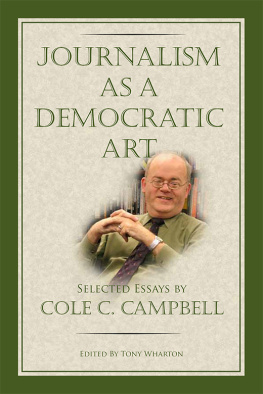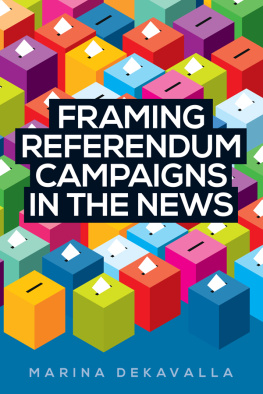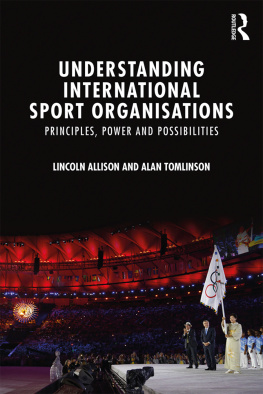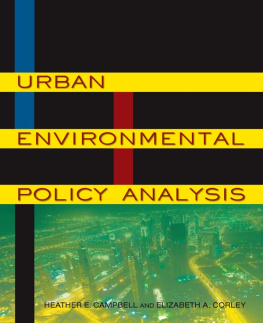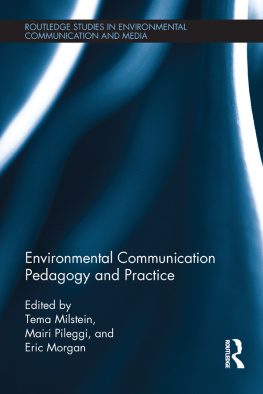THE CONSTRUCTION OF ENVIRONMENTAL NEWS
The Construction of Environmental News
A study of Scottish journalism
FIONA CAMPBELL
First published 1999 by Ashgate Publishing
Reissued 2018 by Routledge
2 Park Square, Milton Park, Abingdon, Oxon, 0X14 4RN
52 Vanderbilt Avenue, New York, NY 10017
Routledge is an imprint of the Taylor & Francis Group, an informa business
Copyright Fiona Campbell 1999
All rights reserved. No part of this book may be reprinted or reproduced or utilised in any form or by any electronic, mechanical, or other means, now known or hereafter invented, including photocopying and recording, or in any information storage or retrieval system, without permission in writing from the publishers.
Notice:
Product or corporate names may be trademarks or registered trademarks, and are used only for identification and explanation without intent to infringe.
Publisher's Note
The publisher has gone to great lengths to ensure the quality of this reprint but points out that some imperfections in the original copies may be apparent.
Disclaimer
The publisher has made every effort to trace copyright holders and welcomes correspondence from those they have been unable to contact.
A Library of Congress record exists under LC control number: 98074204
ISBN 13: 978-1-138-34257-6 (hbk)
ISBN 13: 978-1-138-34258-3 (pbk)
Contents
I should like to thank Dr. Stuart Hannabuss without whose assistance this research would not have taken place and for his generous offer to compile the index. I am also indebted to Mhairi Hardie for her patience in sorting through the work and Grant Davidson for his technical expertise.
Grateful thanks go to all the journalists, both from the print and the broadcast sectors, who took part in the research, for their invaluable assistance. Thanks also go to the media librarians and the environmental and scientific specialists whom I interviewed for the work.
Finally, my thanks go to my friends, family and colleagues for their support and care.
Codes for Journalists
| ECl(n) | Environment Correspondent 1 (Newspaper) |
| EC2(n) | Environment Correspondent 2 (Newspaper) |
| EC(b) | Environment Correspondent (Broadcast) |
| EC(s) | Environment Correspondent for Sunday Newspaper |
| ENJ | Evening Newspaper Journalist |
| JEd | Journal Editor |
| LNA1 | Local News Agency Journalist 1 |
| LNA2 | Local News Agency Journalist 2 |
| LNJ | Local Newspaper Journalist |
| LRJ | Local Radio Journalist |
| LTJ | Local Television Journalist |
| NNJ1 | National Newspaper Journalist 1 |
| NNJ2 | National Newspaper Journalist 2 |
| NRJ1 | National Radio Journalist 1 |
| NRJ2 | National Radio Journalist 2 |
| NTJ | National Television Journalist |
| 1 | National Political Journalist |
| 2 | National Television Journalist |
| 3 | National Bi-media Journalist |
Codes for Scientists
| A | Veterinary Scientist 1 |
| B | Veterinary Scientist 2 |
| C | Agricultural Scientist |
| D | Zoological Scientist |
This book is based on a study carried out between 1992-1996 for a Ph.D degree. Its main purpose is to describe and explain the news process i.e. the journalistic methods used to identify a newsworthy issue; gather the information and construct the story that we read.
The main aim of the work is to explore the construction of environmental news and the information flow that takes place from a state of technical complexity, through retrieval by journalists, to mediation and dissemination via newspapers and television and radio stations. The relationship between science specialist and journalist or what Friedman (1986) calls the symbiosis i.e. the co-existence of two extreme, different professions for the single common aim, is examined.
The main arguments of the work are as follows: Environmental information is pluralistic and complex and has information meanings inherent in it. These are changed when journalists and the audience or readership interpret it. Essentially, environmental news is a version of interpreted environmental information. It is interpreted by the people who use it e.g. librarians, journalists, editors etc. Theorists in the field (Bagdikian, 1984; Ericson, 1987, 1991) support the view that the new technology involved in the news making process causes the creation of new information meaning structures (see ), but this work suggests that as environmental knowledge is retrieved and interpreted by journalists and news practitioners, the meanings which can be taken from this information, change. Therefore, the information changes according to how it is interpreted.
In , it is argued that the flow of knowledge is influenced and redirected by the news process. Primary i.e. unmediated knowledge is altered into a popularised, commercial form and it appears to have been simplified due to the interpretive, journalistic process. In a news report the information may still be complex but it has been shortened and reduced to a series of manageable concepts, thus implying that some of the intellectual content of the original idea has been lost or changed i.e. the knowledge has been popularised. The work takes account of the extent to which the news is structured by the placing of values and meanings on the information, for example, issues of bias or the construction of the news product and its implications for the social construction of reality.
The study included a tri-faceted model which explained how this unmediated knowledge is altered and apparently simplified for audience consumption. The preliminary and secondary stages describe the interaction of the news media with sources of information. This model was designed at a time when very few Scottish journalists had access to electronic information and, unlike today, internet technology was not available. The research, therefore, does not take account of the implications of this technology for the news process and, if this is of interest, I would refer readers to the work carried out by David Nicholas1 at City University which looks at the influence of electronic sources of information on journalistic information gathering (Nicholas, 1997). Parts of the model have been referred to in this text but the tertiary stage which depicts the different journalistic rule categories does not appear in its original form. Modifications had to be made in keeping with the book formatting but the tertiary stage has been adapted without losing the original meanings.
examines the unique relationship between the journalists and the subject specialists. Due to the complex nature of scientific information, journalists refer to scientists during the construction and production of environmental news. This section highlights the expert as a journalistic information source and this is described by the preliminary and secondary stages of the model.



